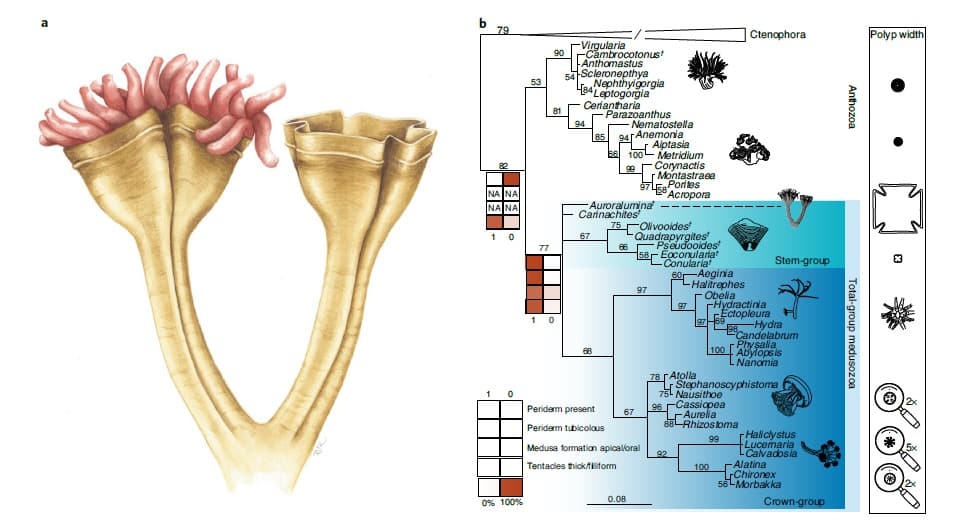(CN) — A fossilized cnidarian recently discovered in the United Kingdom’s Charnwood Forest establishes the body plan of such aquatic invertebrates tens of millions of years before others previously identified.
According to a paper published Monday in the journal Nature Ecology & Evolution, the fossil, named after British broadcaster and naturalist David Attenborough, dates to the Ediacaran Period approximately 557–562 million years ago.
The characteristics of the Charnwood fossil, dubbed Auroralumina attenboroughii, include an impression roughly 7.8 inches in length showing two defined polyps forking from a less distinct base, which is partially obscured by sediment. The polyps display evidence of simple, densely packed tentacles, with the entire fossil resembling a two-headed torch.
The phylum cnidaria comprises mostly marine animals such as corals, jellyfish and sea anemones, which use specialized cells to stun and capture prey. Generally they have two basic body forms: the free-floating medusozoa and anthozoa, which are attached to the sea floor. Their fossil record in the Precambrian Period – a time just before an era of rapid evolutionary development – is spotty, although there have been numerous previous claims of Ediacaran fossils with cnidarian characteristics.
In the study, lead researcher Frances Dunn of the University of Oxford and her team explained why the other claims were debatable, while also declaring that phylogenetic analyses and visual inspection using low-angle light revealed A. attenboroughii to be a stem-group medusozoan and notably, the oldest crown-group cnidarian known to exist.
“Auroralumina demonstrates both the establishment of the crown group of an animal phylum and the fixation of its body plan tens of millions of years before the Cambrian diversification of animal life," the paper states. “Auroralumina confirms the presence of crown-group cnidarians coeval with the oldest assemblage of the Ediacaran macrobiota and is the most ancient fossil that can be reliably ascribed to the crown group of any living animal phylum.”
Dunn said the discovery partially answers a paleontological mystery known as “Darwin’s dilemma.”
“Animals appear globally and in huge number in the Cambrian Period [around] 520 million years ago, but Darwin’s theory of natural selection demands a more ancient ancestry for mutations to accumulate and different lineages to be established and Darwin himself viewed this as one of the greatest problems to his theory,” Dunn said. “Our new fossil goes some way to solving this in demonstrating that animals with direct, living descendants do indeed predate the Cambrian Period.”
The Ediacaran Period was a time of dramatic change for the planet, when the climate was warming after two glacial events and life was evolving from single-celled and microscopic organisms. A supercontinent known as Rodinia was breaking apart and perhaps most importantly, the oceans were becoming oxygenated and more complex organisms appear in the fossil record beginning 580 million years ago.
“The oceans were teeming with life, but the fossils we find from this time are typically very strange and don’t have direct living ancestors,” Dunn said. “Some of these fossils are frond-like, others look a bit like thumb prints, but our new fossil is very different because it has direct, living relatives. Our new fossil is different because it preserves a jellyfish-like exoskeleton plus soft tissues (tentacles) which no either claim for an Ediacaran cnidarian preserve in combination.”
Dunn said evidence suggests the Charnwood specimen was likely at the foot of an ancient underwater volcano, which erupted and preserved Auroralumina and other fossils in much the same way as Vesuvius did to the people of Pompeii.
According to Monday's report, A. attenboroughii extends the fossil record of crown-group cnidarians by around 25 million years, “deep into the Ediacaran period.” It is speculated A. attenboroughii fed on phytoplankton, protists and possibly an emerging zooplankton.
“Animal body plans are widely assumed to have become fixed during the Cambrian explosion but Auroralumina demonstrates that at least one crown-group cnidarian body plan had already been established tens of millions of years previously," the study states.
The genus name Auroralumina means “dawn lantern,” reflecting the fossil’s ancient age, while the species is named to honor Attenborough, who is credited with raising awareness of Ediacaran fossils in the Charnwood Forest.
Subscribe to Closing Arguments
Sign up for new weekly newsletter Closing Arguments to get the latest about ongoing trials, major litigation and hot cases and rulings in courthouses around the U.S. and the world.









